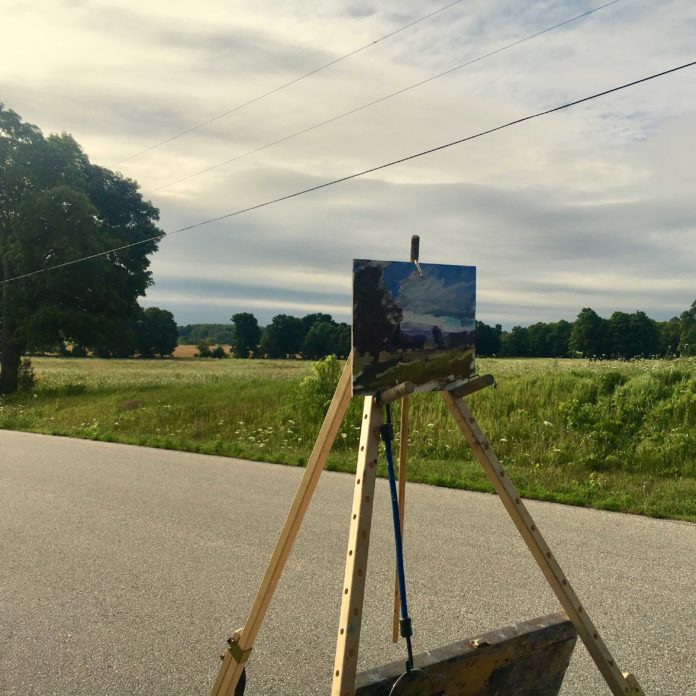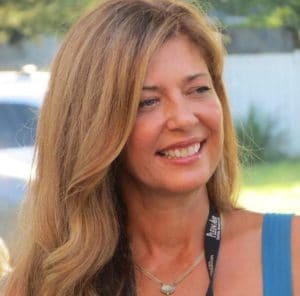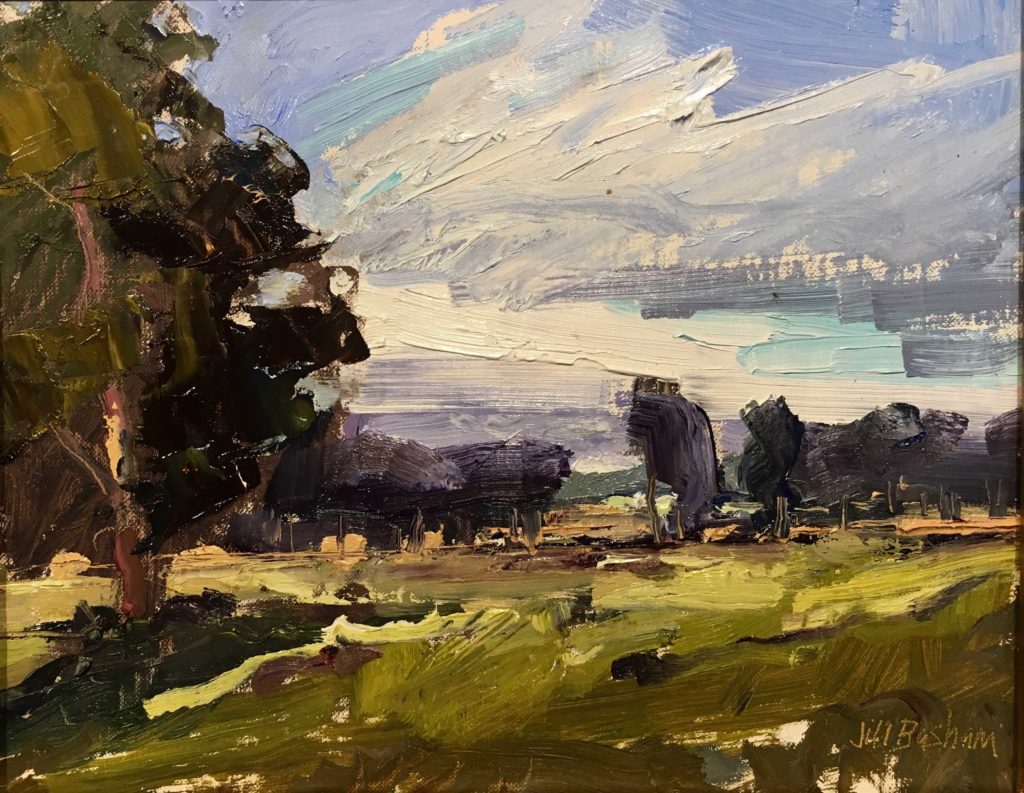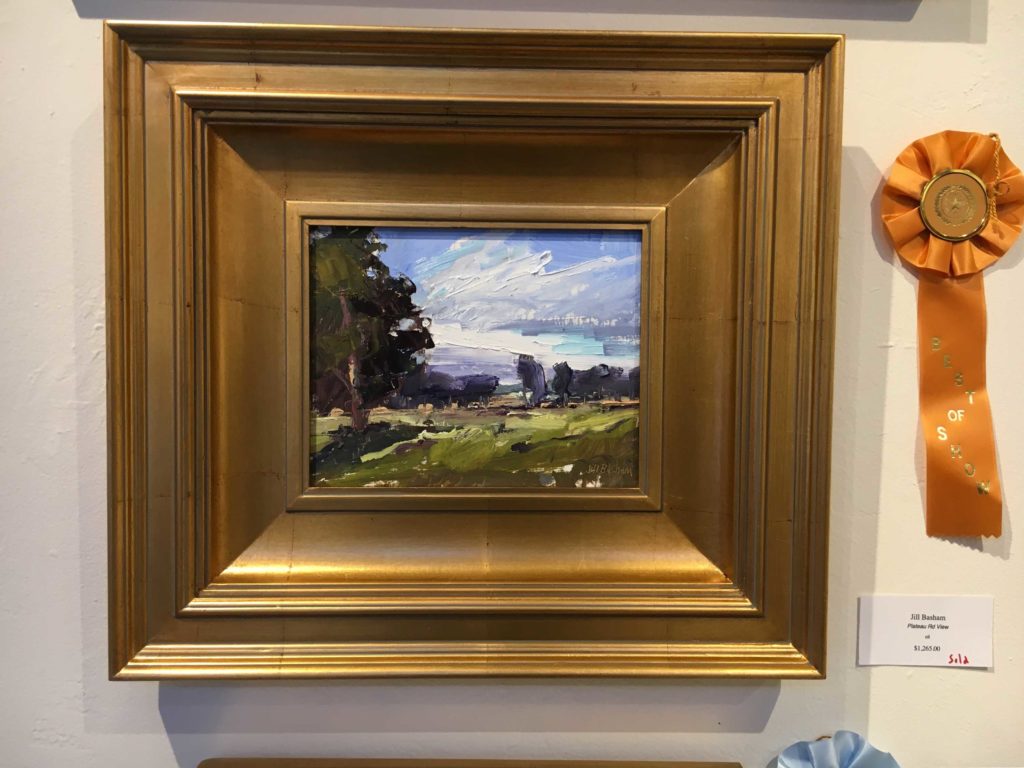
By Jill Basham

What really is the value of a small, alla prima plein air painting — a painting that is completed in one go? Historically, artists such as John Constable and Pierre-Henri de Valenciennes completed outdoor oil sketches in order to gather information for a larger studio painting, never intending for them to be “shown.” Later, the impressionists, who also painted the landscape entirely onsite, created these works as “finished” paintings to show. Today, a true quick, small study is not typical of the work that gets painted or submitted into competitive plein air events. Major plein air competitions bring with them the pressure for artists to create work that somehow stands out amongst a field of high caliber artwork. Often, the idea is to paint larger, more finished work. Sometimes this work may take two to three sittings in the same location, at the same time of day to complete.
I enjoy painting large works outside; I find them freeing. My love of simple, expansive views seems to pair well with a larger format. When I headed off to Door County Plein Air Invitational in Wisconsin as a new artist to the event, I thought I would paint as large as allowed by the rules of the competition. This event came just after my participation in Plein Air Easton, so I arrived in “painting mode,” but a bit tired. To hit the ground running, I decided to explore the region, find an inspiring scene, and paint a location that really spoke to me. Along a quiet farm road, in the rolling countryside between Green Bay and Lake Michigan, I found just the spot. A beautiful view of a roadside tree, with fields and tree lines moving off into the distance. It was a spot that made my heart beat a little faster — I knew this was what I wanted to paint. In order to get the creative juices flowing and loosen up, I pulled out an 8 x 10 panel. Most definitely not my “usual” size.

I had no intention of this sketch being a “competition” piece, or that it had to achieve anything in particular. I so loved what I was seeing and wanted simply to express my appreciation for it in a quick and honest way. As the painting progressed, I went into “autopilot.” This state of being for an artist makes you feel as if you cannot take credit for your own work — it becomes a more subconscious, intuitive painting, which may have taken a couple of hours; I’m not certain. It felt as if it was done in much less time, as time actually disappears when in this “zone.” The choices an artist makes when in this mindset are made based on all past failures as well as successes. When this happens, technical abilities become second nature, while the creative, emotional, responsive mind takes the driver’s seat. It’s when these two things occur simultaneously that my best work surfaces.
At the time, I thought the painting was a solid start, and helpful to refocus. Now off to paint some larger pieces! During the week, the remainder of my work was larger, up to 20 x 24. When it came time to pick our competition pieces, the artists at this event are allotted a space where typically four to five paintings can hang for the potential of earning an award from the judge. Looking at my work, and in order to be able to hang four pieces comfortably considering my penchant for larger paintings, I opted to include my small first “study.” I titled it “Plateau Road View,” in honor of the specific location. I liked the painting but wasn’t certain it would be well received due to its gestural nature and small scale.
Immediately prior to Door County Plein Air Invitational, there had been talk amongst artists regarding the chances a small work would ever be awarded Best of Show at a big plein air event. I certainly didn’t consider my painting to be a contender. I decided to record the awards ceremony to be able to listen again to the remarks made by C.W. Mundy, the awards judge. I thought I could learn from his remarks. Mundy is a master artist and is considered to be one of the best of our time. Prior to the awards, he spoke about the “fundamental truths of the science of painting.” What he called the “objective” part of judging. These truths are “drawing, design, value, color, edges, paint manipulation, and variety and unity.”
Mundy went on to say that the “works were also judged from a very subjective, emotional, and personal viewpoint.” He added, “My subjective response is judged by my initial emotional response at first glance.” He regarded my little sketch as his “interpretation of the classical plein air experience, from Corot to Turner to Edward Seago and Trevor Chamberlain.” What the heck?! Am I dreaming?

C.W. Mundy thinks this about my little painting? I was extremely grateful and stunned beyond words to receive this award, especially considering the extraordinary talent of my fellow artists in this event. In the future, I’m sure I will continue to pull out some large panels, but I now have a newfound respect for working small. Thank you, C.W. Mundy, for taking notice of my little painting. It’s an honor I will never forget!
Visit Jill Basham’s website at www.jillbasham.com.
Do you work on what would be considered a small canvas while painting en plein air? Tell us about it in the comments!




I also do small paintings. Paintings that are plein air and not done in the studio. Living in New York City has size drawbacks.
Hi Steve,
Yes, I certainly understand the challenges of working larger in NYC!
The City can be truly inspiring though!
Thanks for your comment,
Jill
I find the sentences here very disturbing:
Today, a true quick, small study is not typical of the work that gets painted or submitted into competitive plein air events. Major plein air competitions bring with them the pressure for artists to create work that somehow stands out amongst a field of high caliber artwork. Often, the idea is to paint larger, more finished work.
This indicates that the “Plein Air Competition” is false, fake or counter fit. If it is Plein Air, it should be completed as part of the competition. Not staying up all night and finishing it from photos. Misleading, unethical – not as billed.
Perhaps the practice of having paintings “locked up” overnight or at the end of the time given should be instituted. Level the playing field between ethical and ………………………….
Eric spent a whole article on the subject of wanting events to be run a certain way. How exactly does this fit in to make a “quality” event. I for one am very troubled by this.
How do others feel. I invite replies.
Hi Debra,
I appreciate your response. To clarify, I was not insinuating that any plein air competition is “false, fake or counter fit”. Nor was I implying that artists are “staying up all night and finishing from photos”. I’m not sure how you derived this from my sentence?
My reference is concerning work done onsite, it is not alluding to anything else that one might consider against the intent and rules of the competition.
Thanks for taking the time to read the blog,
Jill
Congratulations, I love your painting and am glad to see that it won Best of Show! I enjoyed your story too.
Thank you, Deborah! I appreciate you taking the time to read the blog! Door County is an inspiring place to paint!
Jill
Hi Jill:
I was in DoorCounty when your little jewel of a piece won. I was really happy to hear and see CW Mundy. I had not seen him since I left Indianapolis 14 years ago.
I am not sure what Debra was referencing, but I have painted in competitions that artists did not paint the work onsite at all but took a photo and left.
Hi Erlene,
Thanks for your comment. I’m just now seeing this. I believe the biggest injustice to taking a photo and leaving during a plein air competition is to the artist him/herself as they miss out on an incredible opportunity to learn from light and natural surroundings. I do believe it shows in the results of the work.
Hope to see you in Door this year!
Jill
[…] Read her blog for OPA and article for OutdoorPainter.com: http://blog.oilpaintersofamerica.com/2018/07/for-the-love-of-it/ https://www.outdoorpainter.com/my-little-plein-air-painting/ […]